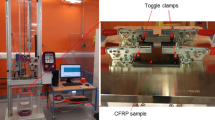Abstract
Methods have been developed to describe the fatigue initiation and propagation mechanisms in flat panels as well as mechanically fastened joints and to determine the residual strength of large flat panels. Glare shows excellent crack growth characteristics due to the mechanism of delamination and fibre bridging. The fatigue insensitive fibres restrain the crack opening and transfer load over the crack in the metal layers. During the initiation phase fibre bridging does not occur and the behaviour is dominated by the metal initiation properties. Mechanically fastened joints introduce additional effects such as secondary bending, load transfer and aspects related to the fastener installation. The residual strength of Glare is dependent on the amount of broken fibres and the delamination size and can be described with the R-curve approach.
The impact resistance of Glare is related to the aluminium and glass/epoxy properties and is significantly higher than the impact resistance of monolithic aluminium. The same has been proven for fire resistance. Depending on the Glare grade and thickness, the outer aluminium layer will melt away, whereas the other layers will remain intact due to carbonisation of the glass/epoxy layers and delamination of the laminate. The air in the delaminations will act as insulation, keeping the temperatures at the non-exposed side relatively low.
Similar content being viewed by others
References
Kieboom, O. T., ‘Fatigue Crack Initiation and Early Crack Growth in Glare at Different Temperatures,’ Master thesis, Structures and Materials Laboratory, Faculty of Aerospace Engineering, Delft University of Technology, November 2000.
Alderliesten, R. C., ‘Development of an Empirical Fatigue Crack Growth Prediction Model for the Fibre Metal Laminate Glare,’ Master thesis, Structures and Materials Laboratory, Faculty of Aerospace Engineering, Delft University of Technology, 14 December 1999.
Marissen, R., ‘Fatigue Crack Growth in ARALL, a Hybrid Aluminium-Aramid Composite Material, Crack Growth Mechanisms and Quantitative Predictions of the Crack Growth Rate,’ PhD thesis, June 1988, Report LR-574, Faculty of Aerospace Engineering, Delft University of Technology.
Woerden, H. J. M., ‘Variable Amplitude Fatigue of Glare® 3, Influence of Peak Loads and Flight Spectrum Development,’ Preliminary thesis, Structures and Materials Laboratory, Faculty of Aerospace Engineering, Delft University of Technology, May 1998.
Gonesh, K. A. M., ‘Development of a Fatigue Crack Growth Model for Surface Cracks in GLARE,’ Master thesis, Structures and Materials Laboratory, Faculty of Aerospace Engineering, Delft University of Technology, August 2000.
van der Hoeven, W., ‘Final Report Glare Durability Program, Results of Tests Carried out at NLR,’ NLR-CR-2000-237, National Aerospace Laboratory NLR, 2000.
Jarfall, L., ‘Shear Loaded Fastener Installations,’ Saab-Scania Report KHR-3360, April 1983.
Müller, R. P. G., ‘An Experimental and Analytical Investigation on the Fatigue Behaviour of Fuselage Riveted Lap Joints,’ Doctor thesis, Delft University of Technology, 1995.
Schijve, J., ‘Some Elementary Calculations on Secondary Bending in Simple Lap Joints,’ NLRTR-72036.
De Rijck, J. J. M. and Fawaz, S. A., ‘A Simplified Approach for Stress Analysis of Mechanically Fastened Joints,’ 4th Joint DoD/FAA/NASA Conference on Aging Aircraft, St. Louis, May 2000.
Pellenkoft, F., ‘Secondary Bending in Glare - Investigation on the Elastic Behaviour of and Crack Propagation in Glare Loaded by Combined Tension and Bending,’ Masters thesis, TU Delft, 2000.
Homan, J. J. and Jongebreur, A. A., ‘Calculation Method for Predicting the Fatigue Life of Riveted Joints,’ Proceedings of International Conference on Aircraft Fatigue, Stockholm, 1993, pp. 17–190.
Vlot, A., ‘Low-velocity Impact Loading - on Fibre Reinforced Aluminium Laminates (Arall) and Other Aircraft Sheet Materials,’ PhD thesis, Delft University of Technology, 1991.
Vlot, A., ‘Impact Loading on Fibre Metal Laminate,’ International Journal of Impact Engineering 18(3), 1996, 29–307.
Davis, G. W. and Sakata, I. F., ‘Design Considerations for Composite Fuselage Structure of Commercial Transport Aircraft,’ NASA CR 159296, 1981.
Hagenbeek, M., ‘Impact of Ice, Impact Properties of Glare,’ Report B2v-98-15, Delft University of Technology, Delft, February 1999.
Homan, J. J., ‘Compression after Impact,’ Report B2v-98-11, Delft University of Technology, Delft, December 1998.
van der Kevie, G., ‘The Modification of Glare to Develop a more Fire-resistant and Non-delaminating Fuselage Skin for the Airbus A3XX,’ Master thesis, Delft University of Technology, Faculty of Aerospace Engineering, 1997.
Reid, G. W., ‘Mechanical Damage to Aircraft Structures from Lightning Strikes,’ Journal of Aerospace Engineering, Part G 207, 1993, –14.
Dodd, D. C., Hall, C. T. M., Pollard, J. and Snell, M. A., ‘Burn through Resistance of Fuselages: Initial Findings,’ Civil Aviation Authority CAA Paper 94002, London, July 1994.
Roebroeks, G. H. J. J., ‘Glare; a Structural Material for Fire Resistant Fuselages,’ Aircraft Fire Safety, AGARD Conference Proceedings 587, October 1996, pp. 26-–26-13.
Vermeeren, C. A. J. R., ‘The Residual Strength of Fibre Metal Laminates,’ PhD thesis, Faculty of Aerospace Engineering, Delft University of Technology, The Netherlands, 1995.
de Vries, T. J. and Pacchione, M., ‘The Application of the R-curve Concept for the Prediction of the Residual Strength of Fiber Metal Laminates,’ Proceedings of the 1995 USAF Structural Integrity Program Conference, WL-TR-96-4093, United States, 1996.
de Vries, T. J., ‘Various Parameters Concerning the Residual Strength of Aircraft Materials,’ Master thesis, Faculty of Aerospace Engineering, Delft University of Technology, The Netherlands, 1994.
Author information
Authors and Affiliations
Rights and permissions
About this article
Cite this article
Alderliesten, R.C., Hagenbeek, M., Homan, J.J. et al. Fatigue and Damage Tolerance of Glare. Applied Composite Materials 10, 223–242 (2003). https://doi.org/10.1023/A:1025537818644
Issue Date:
DOI: https://doi.org/10.1023/A:1025537818644




